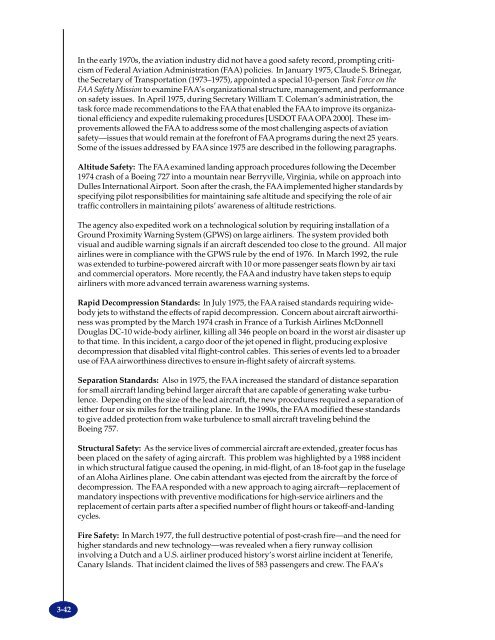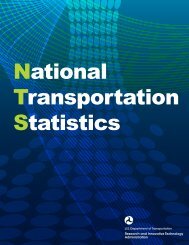TRANSPORTATION - BTS - Bureau of Transportation Statistics
TRANSPORTATION - BTS - Bureau of Transportation Statistics
TRANSPORTATION - BTS - Bureau of Transportation Statistics
You also want an ePaper? Increase the reach of your titles
YUMPU automatically turns print PDFs into web optimized ePapers that Google loves.
In the early 1970s, the aviation industry did not have a good safety record, prompting criticism<strong>of</strong> Federal Aviation Administration (FAA) policies. In January 1975, Claude S. Brinegar,the Secretary <strong>of</strong> <strong>Transportation</strong> (1973–1975), appointed a special 10-person Task Force on theFAA Safety Mission to examine FAA’s organizational structure, management, and performanceon safety issues. In April 1975, during Secretary William T. Coleman’s administration, thetask force made recommendations to the FAA that enabled the FAA to improve its organizationalefficiency and expedite rulemaking procedures [USDOT FAA OPA 2000]. These improvementsallowed the FAA to address some <strong>of</strong> the most challenging aspects <strong>of</strong> aviationsafety—issues that would remain at the forefront <strong>of</strong> FAA programs during the next 25 years.Some <strong>of</strong> the issues addressed by FAA since 1975 are described in the following paragraphs.Altitude Safety: The FAA examined landing approach procedures following the December1974 crash <strong>of</strong> a Boeing 727 into a mountain near Berryville, Virginia, while on approach intoDulles International Airport. Soon after the crash, the FAA implemented higher standards byspecifying pilot responsibilities for maintaining safe altitude and specifying the role <strong>of</strong> airtraffic controllers in maintaining pilots’ awareness <strong>of</strong> altitude restrictions.The agency also expedited work on a technological solution by requiring installation <strong>of</strong> aGround Proximity Warning System (GPWS) on large airliners. The system provided bothvisual and audible warning signals if an aircraft descended too close to the ground. All majorairlines were in compliance with the GPWS rule by the end <strong>of</strong> 1976. In March 1992, the rulewas extended to turbine-powered aircraft with 10 or more passenger seats flown by air taxiand commercial operators. More recently, the FAA and industry have taken steps to equipairliners with more advanced terrain awareness warning systems.Rapid Decompression Standards: In July 1975, the FAA raised standards requiring widebodyjets to withstand the effects <strong>of</strong> rapid decompression. Concern about aircraft airworthinesswas prompted by the March 1974 crash in France <strong>of</strong> a Turkish Airlines McDonnellDouglas DC-10 wide-body airliner, killing all 346 people on board in the worst air disaster upto that time. In this incident, a cargo door <strong>of</strong> the jet opened in flight, producing explosivedecompression that disabled vital flight-control cables. This series <strong>of</strong> events led to a broaderuse <strong>of</strong> FAA airworthiness directives to ensure in-flight safety <strong>of</strong> aircraft systems.Separation Standards: Also in 1975, the FAA increased the standard <strong>of</strong> distance separationfor small aircraft landing behind larger aircraft that are capable <strong>of</strong> generating wake turbulence.Depending on the size <strong>of</strong> the lead aircraft, the new procedures required a separation <strong>of</strong>either four or six miles for the trailing plane. In the 1990s, the FAA modified these standardsto give added protection from wake turbulence to small aircraft traveling behind theBoeing 757.Structural Safety: As the service lives <strong>of</strong> commercial aircraft are extended, greater focus hasbeen placed on the safety <strong>of</strong> aging aircraft. This problem was highlighted by a 1988 incidentin which structural fatigue caused the opening, in mid-flight, <strong>of</strong> an 18-foot gap in the fuselage<strong>of</strong> an Aloha Airlines plane. One cabin attendant was ejected from the aircraft by the force <strong>of</strong>decompression. The FAA responded with a new approach to aging aircraft—replacement <strong>of</strong>mandatory inspections with preventive modifications for high-service airliners and thereplacement <strong>of</strong> certain parts after a specified number <strong>of</strong> flight hours or take<strong>of</strong>f-and-landingcycles.Fire Safety: In March 1977, the full destructive potential <strong>of</strong> post-crash fire—and the need forhigher standards and new technology—was revealed when a fiery runway collisioninvolving a Dutch and a U.S. airliner produced history’s worst airline incident at Tenerife,Canary Islands. That incident claimed the lives <strong>of</strong> 583 passengers and crew. The FAA’s3-42
















